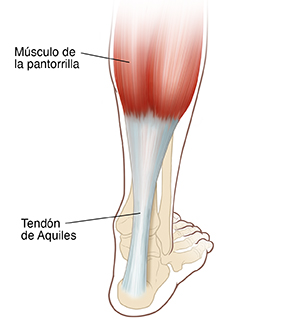El tendón de Aquiles es un cordón fuerte y fibroso que se encuentra en la pantorrilla. Conecta los músculos de la pantorrilla con el talón. Es el tendón más grande del cuerpo. Lo ayuda a caminar, correr y saltar. La cirugía de reparación del tendón de Aquiles repara el tendón dañado.
¿Por qué se hace una cirugía de reparación del tendón de Aquiles?
La cirugía se realiza si sufre una ruptura o desgarro repentino. O bien, si ya presentaba desgaste, uso excesivo, desgarro o lesiones por alguna otra afección. Esta lesión a largo plazo se conoce como tendinitis o tendinopatía.
¿Cómo se hace una cirugía de reparación del tendón de Aquiles?
Un cirujano ortopédico realiza la reparación del tendón de Aquiles. Este cirujano se especializa en tratar problemas de huesos, músculos, articulaciones y tendones. La cirugía puede hacerse de diferentes maneras. El cirujano le hará un corte (una incisión) en la piel y el músculo de la parte posterior de la pantorrilla. Si le hacen una cirugía mínimamente invasiva, el cirujano hará varias incisiones pequeñas en lugar de un solo corte grande. El cirujano le hará un corte en la vaina o el recubrimiento del tendón de Aquiles. Si el tendón está dañado, el cirujano puede quitar la parte dañada y reparar el resto. Si el daño es grave, el cirujano puede usar músculo o tendón de la pantorrilla, el tobillo o el pie para la reparación.
Riesgos de la cirugía de reparación del tendón de Aquiles
Toda cirugía tiene algunos riesgos. Los riesgos de la cirugía para reparar el tendón de Aquiles incluyen los siguientes:
-
Sangrado
-
Lesión en los nervios
-
Infección
-
Coágulos de sangre
-
Dificultades de cicatrización de las heridas
-
Debilidad de la pantorrilla
-
Problemas causados por la anestesia
-
Dolor persistente en el pie y el tobillo
Los riesgos dependen de factores tales como su edad, su estado general de salud y el tipo de cirugía que se realice. También dependen de la forma del pie, los músculos y los tendones. Consulte con el cirujano cuáles son los riesgos más probables en su caso. Hable con él sobre cualquier inquietud que tenga.
Featured in


